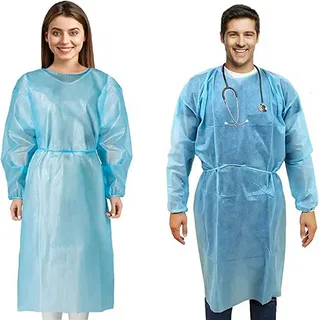Protective gowns have emerged as essential gear for various industries in a world where safety is paramount. Whether in healthcare, laboratories, or construction sites, these garments are a crucial barrier between you and potential hazards. With the right protective gown, you can confidently face risks while maintaining your well-being. But what should you look for when choosing one? This guide will explore everything from key features to materials that make an isolation gown effective. Let’s dive into how this personal protective equipment can safeguard your safety with unwavering confidence.
Why Are Protective Gowns Essential for Safety?
Protective gowns play a crucial role in ensuring safety across various settings. They act as a barrier against harmful substances, liquids, and contaminants that could pose serious health risks. In environments like hospitals or laboratories, the potential for exposure to infectious agents makes wearing protective gowns vital.
Moreover, these gowns are designed to provide comfort while maintaining functionality. Their lightweight fabric allows for ease of movement without compromising protection. This balance is essential for professionals performing their tasks efficiently and safely.
Additionally, protective gowns contribute significantly to compliance with safety regulations. Using them helps organizations meet industry standards while fostering a safety culture among employees. As such, investing in quality protective gowns is not just practical; it’s also responsible.
Key Features to Look for in a Protective Gown
When selecting a protective gown, it is essential to consider the following key features:
Material
The gown’s material should be durable and resistant to tears, punctures, and chemicals. Common materials used for protective gowns include polypropylene, polyester, and microporous laminates.
Coverage
The gown should fully cover the body, including arms and legs. Some gowns also have attached hoods or booties for added protection.
Breathability
A breathable material is essential to prevent overheating and discomfort for the wearer. Look for gowns with breathable fabrics or ventilation panels.
Fluid resistance
If the gown will be used in settings where there is a risk of exposure to bodily fluids or other liquids, it should have a level of fluid resistance indicated by its ASTM rating.
Closures
Gowns may have tie closures or snaps to secure them in place. For best protection, make sure these closures are sturdy and easy to fasten.
Choosing the Right Personal Protective Equipment
Selecting the proper personal protective equipment (PPE) is crucial for your safety in various environments. Start by assessing the hazards you’ll encounter, such as chemicals, biological agents, or physical risks. Understanding these elements helps guide your PPE choices.
Next, consider comfort and fit. A protective gown that is too tight can restrict movement, while one that’s too loose may expose you to dangers. It’s essential to try on different sizes and styles to find what works best. Always prioritize quality over price when choosing a protective gown. Look for certifications and standards from reputable organizations. Investing in high-quality PPE ensures maximum protection without compromising comfort during long hours of wear.
How Protective Clothing Enhances Workplace Safety?
Protective clothing plays a vital role in enhancing workplace safety across various industries. When employees wear the appropriate protective gowns, they significantly reduce their risk of exposure to hazards, such as biological agents, chemicals, or even physical injuries.
The right gown creates a barrier that limits contact with harmful substances. It also boosts confidence among workers, knowing they are adequately protected while performing their tasks. Enhanced morale often leads to increased productivity and focus on the job rather than worrying about potential dangers. In environments where spills and splashes occur daily, such as laboratories and healthcare facilities, protective gowns act as an essential line of defence. They prevent contaminants from reaching the skin or personal clothing, which could lead to serious health issues.
Moreover, implementing strict protocols regarding protective clothing protects individual employees and promotes a culture of safety within the organization. As team members see their colleagues adhering to these standards, they foster collective responsibility for one another’s well-being.
Durability and Comfort in Protective Gowns
When selecting a protective gown, durability and comfort go hand in hand. A high-quality gown should withstand the rigours of daily use while providing reliable protection against contaminants. Look for materials that resist tears and punctures to ensure longevity.
Comfort is equally important, especially during long hours of wear. Breathable fabrics help regulate body temperature, preventing overheating and allowing for ease of movement. Gowns with adjustable features can accommodate various body types, enhancing fit and comfort.
Choosing a gown that prioritizes both durability and comfort helps workers focus on their tasks without distraction from discomfort or concerns about garment integrity. Investing in quality protective gowns ultimately enhances safety protocols in any environment requiring personal protective equipment.
Isolation Gown: Your First Line of Defense in Hazardous Environments
Protective gowns serve as a crucial barrier against harmful substances in hazardous environments. Whether in healthcare, laboratories, or construction sites, they shield skin from contaminants and toxic agents. They act as the first line of defence when every second counts.
Wearing a reliable isolation gown minimizes exposure to chemicals and biological hazards and promotes confidence among workers. Knowing you have that layer of protection allows you to focus entirely on the task without distraction.
Moreover, modern designs prioritize breathability and comfort while maintaining safety standards. This ensures that even during extended wear, professionals can remain comfortable and practical without compromising protection or mobility.
Materials That Make a Protective Gown Effective
The effectiveness of a protective gown heavily relies on the materials used in its construction. Non-woven fabrics, such as polypropylene, are popular due to their lightweight and breathable nature. These materials protect against fluids and particles while ensuring comfort during extended wear.
Another key material is polyethylene, which offers excellent waterproofing properties. This makes it ideal for environments where liquid exposure is a concern, providing an extra layer of defence against contaminants. Additionally, gowns made from antimicrobial fabrics can help reduce the risk of infection in healthcare settings. By inhibiting bacterial growth, these innovative materials enhance safety without compromising comfort or mobility for the wearer.
Understanding the Different Types of Protective Gowns
Protective gowns come in various types, each designed for specific applications. Medical gowns are commonly used in healthcare settings to minimize the risk of infection during procedures. They often feature materials that repel fluids while allowing breathability.
Protective gowns serve a similar purpose but are typically worn by healthcare workers when interacting with patients who may be contagious. These gowns provide an extra layer of protection, ensuring safety for both caregivers and patients. For industrial settings, chemical-resistant gowns offer vital defence against hazardous substances. These gowns are made from specialized materials and can withstand spills and splashes from dangerous chemicals, keeping workers safe in high-risk environments. Understanding these distinctions helps ensure you choose the right protective gown for your needs.
Where to Buy Quality Protective Gowns for Maximum Safety?
When sourcing quality protective gowns, opt for reputable medical supply companies. These suppliers often carry a wide range of options that meet industry standards. Researching their certifications can assure you of the product’s reliability.
Online marketplaces and specialized health equipment websites are great places to explore various brands and user reviews. Please pay attention to customer feedback, as it provides insights into durability and comfort. Consider contacting manufacturers or wholesalers specializing in personal protective equipment (PPE) for bulk purchases. They may offer competitive pricing and customizable options suitable for specific work environments. Always prioritize safety by investing in gowns that have proven effectiveness against hazards.
Conclusion
Isolation gowns play a crucial role in maintaining safety across various industries. Their ability to shield against contaminants, chemicals, and other hazards cannot be overstated. Choosing high-quality materials and considering comfort alongside durability ensures optimal protection for yourself or your team. Investing in the proper protective gown is essential whether working in healthcare, laboratories, or any hazardous environment. Prioritize safety and confidently empower yourself as you navigate potential risks in your professional landscape.
FAQs
Protective gowns are crucial in various settings. They provide essential barriers against potential hazards, ensuring safety for healthcare workers, industrial staff, and anyone exposed to harmful substances. Understanding their features and material types is vital for making informed choices with an array of options available.
Choosing the right protective gown ensures maximum effectiveness. When selecting your gear, consider factors like comfort, durability, and specific industry needs. Always prioritize quality to ensure adequate protection.
When looking for reliable sources to purchase protective gowns, opt for reputable suppliers offering high-quality products tailored to different environments. Prioritize those that meet safety standards and regulations set forth by health authorities.
What is an isolation gown used for?
An isolation gown shields wearers from contaminants or hazardous materials in environments such as hospitals or laboratories.
Are all protective gowns disposable?
Not all protective gowns are disposable; depending on the intended application and level of protection required, they are available in both reusable and single-use options.
How do I know which size protective gown I need?
Size guidelines vary by manufacturer; always refer to sizing charts provided by suppliers to find the best fit based on your measurements.
| Related Business Listings |
| Contact Directory |
| Local Business Profiles |



